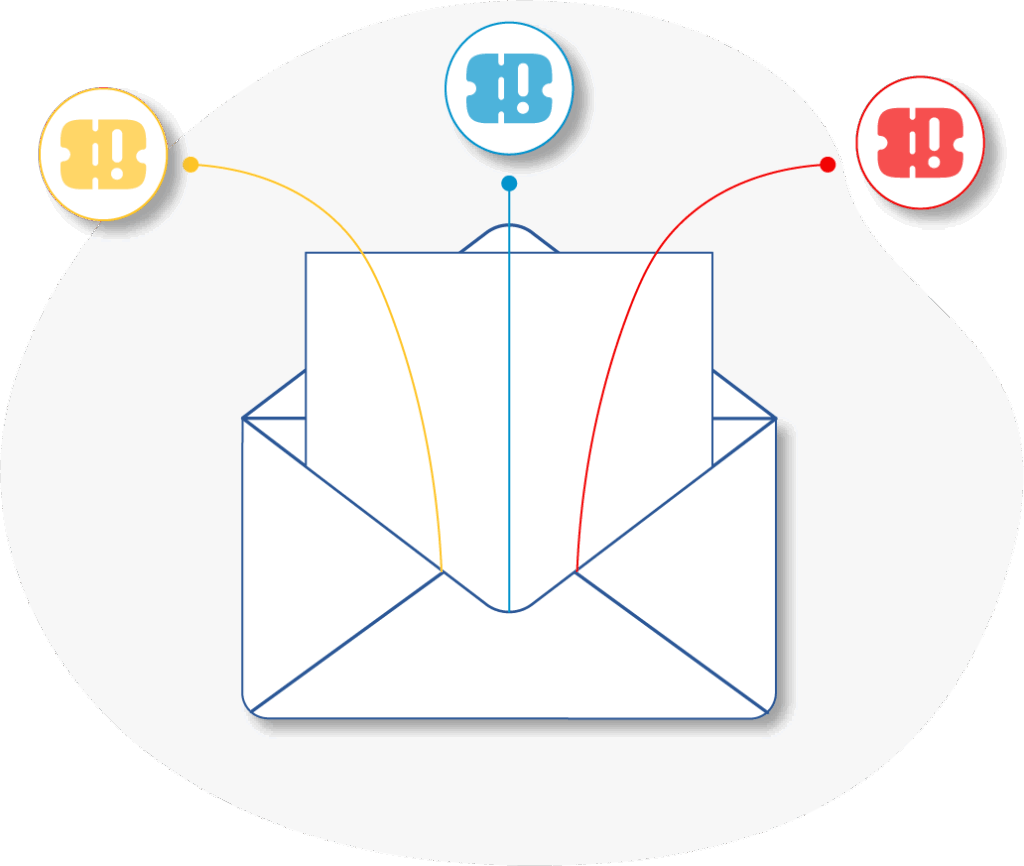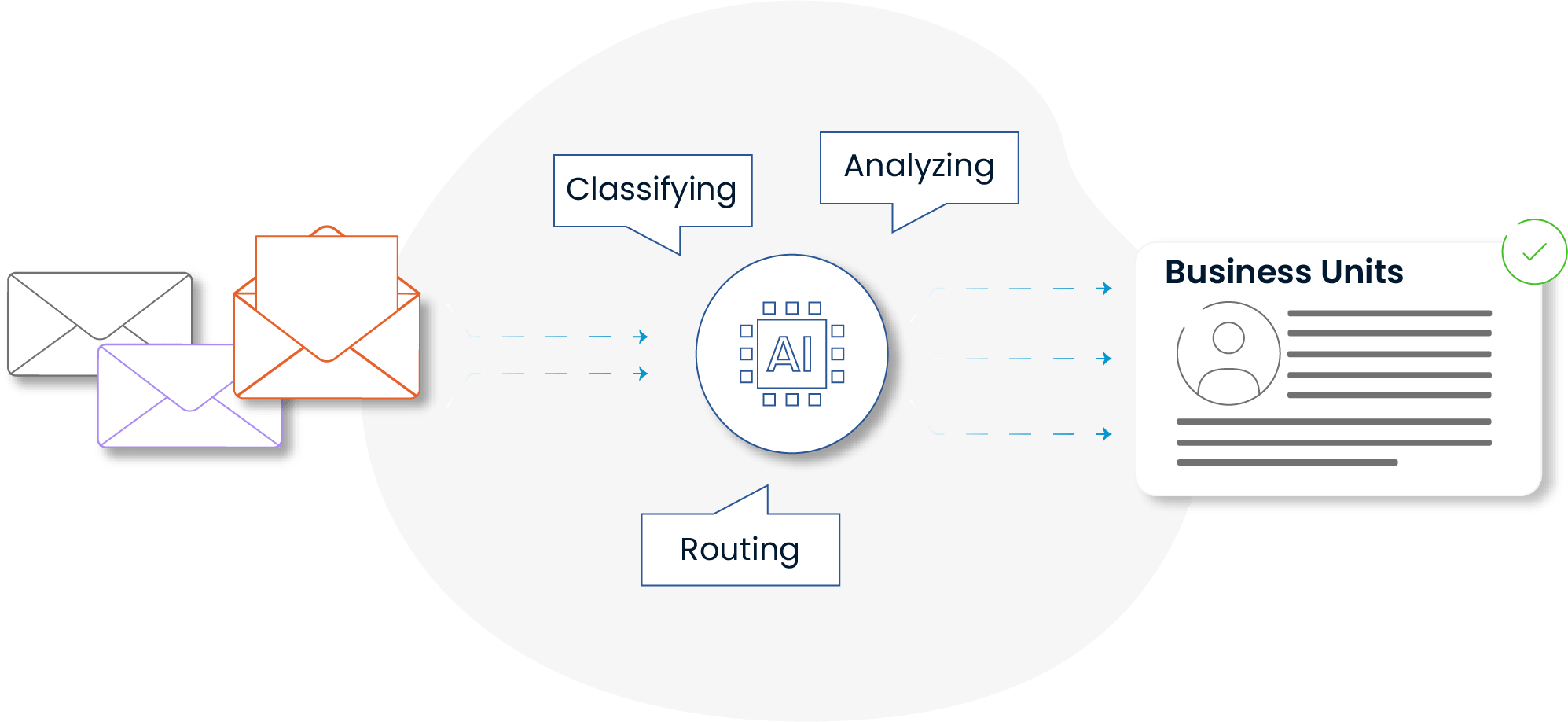Mail-to-Ticket
With the mail-to-ticket module, ensure that issues, requests or notifications that users send to the support team via e-mail are automatically opened as a ticket (service request). Reduce manual workload, automate your ITSM processes and maximize user satisfaction!


With the mail-to-ticket module, ensure that issues, requests or notifications that users send to the support team via e-mail are automatically opened as a ticket (service request). Reduce manual workload, automate your ITSM processes and maximize user satisfaction!
Benefits of the Mail-to-Ticket

Eliminates manual processing burden. Without the need for support teams to constantly check their e-mail boxes, each incoming request automatically turns into a ticket in the system. In this way, the team saves time and can focus on more critical tasks.

All communication is centralized in a single system. Requests from users are recorded in the ticket system, eliminating the risk of being lost or forgotten. It also converts incoming emails into traceable service requests and enables businesses to manage customer requests more efficiently.

When processes are automated, human errors are minimized. Overlooks, misdirections or forgotten requests in manually tracked emails are eliminated. Tickets are processed according to standard procedures within the system, providing a more consistent and reliable support process.

Provides concrete data for performance measurements. Since every ticket is timestamped, metrics such as response time, resolution time and user satisfaction can be easily analyzed. In this way, indicators such as SLA (Service Level Agreement) and XLA (Experience Level Agreement) are effectively monitored and opportunities for improvement can be identified.

A more systematic and organized service demand occurs. Resource management becomes more effective with automated processes. Support requests can be prioritized, categorized and directed to the relevant people, reducing processing time. As a result, the team can serve more users faster with less effort.
Eliminates manual processing burden. Without the need for support teams to constantly check their e-mail boxes, each incoming request automatically turns into a ticket in the system. In this way, the team saves time and can focus on more critical tasks.
All communication is centralized in a single system. Requests from users are recorded in the ticket system, eliminating the risk of being lost or forgotten. It also converts incoming emails into traceable service requests and enables businesses to manage customer requests more efficiently.
When processes are automated, human errors are minimized. Overlooks, misdirections or forgotten requests in manually tracked emails are eliminated. Tickets are processed according to standard procedures within the system, providing a more consistent and reliable support process.
Provides concrete data for performance measurements. Since every ticket is timestamped, metrics such as response time, resolution time and user satisfaction can be easily analyzed. In this way, indicators such as SLA (Service Level Agreement) and XLA (Experience Level Agreement) are effectively monitored and opportunities for improvement can be identified.
A more systematic and organized service demand occurs. Resource management becomes more effective with automated processes. Support requests can be prioritized, categorized and directed to the relevant people, reducing processing time. As a result, the team can serve more users faster with less effort.

Warning: Undefined array key "background_image" in /home/spidyac/public_html/wp-content/plugins/elementor/includes/conditions.php on line 87
Warning: Trying to access array offset on value of type null in /home/spidyac/public_html/wp-content/plugins/elementor/includes/conditions.php on line 90
Warning: Undefined array key "background_image" in /home/spidyac/public_html/wp-content/plugins/elementor/includes/conditions.php on line 87
Warning: Trying to access array offset on value of type null in /home/spidyac/public_html/wp-content/plugins/elementor/includes/conditions.php on line 90
Warning: Undefined array key "background_image" in /home/spidyac/public_html/wp-content/plugins/elementor/includes/conditions.php on line 87
Warning: Trying to access array offset on value of type null in /home/spidyac/public_html/wp-content/plugins/elementor/includes/conditions.php on line 90
Warning: Undefined array key "background_image" in /home/spidyac/public_html/wp-content/plugins/elementor/includes/conditions.php on line 87
Warning: Trying to access array offset on value of type null in /home/spidyac/public_html/wp-content/plugins/elementor/includes/conditions.php on line 90
AI can automatically extract the subject, description, event type and related systems from the email content. This makes ticket creation both more accurate and faster.
The title and description fields from the email content are analyzed to understand what the subject is about and automatically classify it. In this way, tickets are routed to the right teams without the need for human intervention, speeding up the process and reducing the margin for error.

Warning: Undefined array key "background_image" in /home/spidyac/public_html/wp-content/plugins/elementor/includes/conditions.php on line 87
Warning: Trying to access array offset on value of type null in /home/spidyac/public_html/wp-content/plugins/elementor/includes/conditions.php on line 90
Warning: Undefined array key "background_image" in /home/spidyac/public_html/wp-content/plugins/elementor/includes/conditions.php on line 87
Warning: Trying to access array offset on value of type null in /home/spidyac/public_html/wp-content/plugins/elementor/includes/conditions.php on line 90
Warning: Undefined array key "background_image" in /home/spidyac/public_html/wp-content/plugins/elementor/includes/conditions.php on line 87
Warning: Trying to access array offset on value of type null in /home/spidyac/public_html/wp-content/plugins/elementor/includes/conditions.php on line 90
Warning: Undefined array key "background_image" in /home/spidyac/public_html/wp-content/plugins/elementor/includes/conditions.php on line 87
Warning: Trying to access array offset on value of type null in /home/spidyac/public_html/wp-content/plugins/elementor/includes/conditions.php on line 90
All mails that arrive at a specific e-mail address are automatically detected by the system and are first classified by analyzing the content. At this stage, the information, attachments and sender details contained in the mails are evaluated by the system. This data is then structured to be directed to the appropriate processing processes and made ready for processing.
The AI-based system can read and process multiple incoming emails in parallel. This capability prevents the system from clogging up in environments with heavy support requests; it ensures that each e-mail is quickly analyzed and queued for processing without delay.

Warning: Undefined array key "background_image" in /home/spidyac/public_html/wp-content/plugins/elementor/includes/conditions.php on line 87
Warning: Trying to access array offset on value of type null in /home/spidyac/public_html/wp-content/plugins/elementor/includes/conditions.php on line 90
Warning: Undefined array key "background_image" in /home/spidyac/public_html/wp-content/plugins/elementor/includes/conditions.php on line 87
Warning: Trying to access array offset on value of type null in /home/spidyac/public_html/wp-content/plugins/elementor/includes/conditions.php on line 90
Warning: Undefined array key "background_image" in /home/spidyac/public_html/wp-content/plugins/elementor/includes/conditions.php on line 87
Warning: Trying to access array offset on value of type null in /home/spidyac/public_html/wp-content/plugins/elementor/includes/conditions.php on line 90
Warning: Undefined array key "background_image" in /home/spidyac/public_html/wp-content/plugins/elementor/includes/conditions.php on line 87
Warning: Trying to access array offset on value of type null in /home/spidyac/public_html/wp-content/plugins/elementor/includes/conditions.php on line 90
When a ticket is opened, an automatic e-mail is sent to the user, and the user is informed about updates depending on the situation.
AI-powered automated response systems can provide initial responses that are personalized according to the content of the email, even including the solution to the problem. This increases resolution rates and reduces the burden on the service desk.

Eliminates manual processing burden. Without the need for support teams to constantly check their e-mail boxes, each incoming request automatically turns into a ticket in the system. In this way, the team saves time and can focus on more critical tasks.

All communication is centralized in a single system. Requests from users are recorded in the ticket system, eliminating the risk of being lost or forgotten. It also converts incoming emails into traceable service requests and enables businesses to manage customer requests more efficiently.

When processes are automated, human errors are minimized. Overlooks, misdirections or forgotten requests in manually tracked emails are eliminated. Tickets are processed according to standard procedures within the system, providing a more consistent and reliable support process.

Provides concrete data for performance measurements. Since every ticket is timestamped, metrics such as response time, resolution time and user satisfaction can be easily analyzed. In this way, indicators such as SLA (Service Level Agreement) and XLA (Experience Level Agreement) are effectively monitored and opportunities for improvement can be identified.

A more systematic and organized service demand occurs. Resource management becomes more effective with automated processes. Support requests can be prioritized, categorized and directed to the relevant people, reducing processing time. As a result, the team can serve more users faster with less effort.
Features of the Mail-to-Ticket

Automatic Ticket Generation
E-mail Integration


Notification and Response Management



Frequently Asked Questions (FAQ)
The mail-to-ticket module automatically transfers requests received at one or more e-mail addresses to the support system and creates a ticket. The system analyzes the subject and content of the email and places it in the appropriate fields. This eliminates the manual registration process and support requests are processed immediately.
Artificial intelligence can analyze incoming email content and take on functions such as categorization, prioritization and automatic solution suggestions. AI-powered systems also have the capacity to review past requests and recommend the most appropriate solution.
This module acts as the central registration point of the service desk, making all requests organized and traceable. Directing requests to the right people, SLA tracking and reporting are carried out more efficiently. At the same time, when integrated with knowledge bases, it reduces the workload of the service desk by providing instant solutions to common problems
Mail-to-ticket systems are protected by secure connections and authentication steps. Furthermore, unwanted content can be weeded out thanks to filtering rules, such as only processing messages from designated email addresses. AI-powered systems can further increase the level of security by detecting potential spam or phishing attempts.
Files that users attach to their emails (e.g. log files, screenshots) are automatically added to the ticket system. With AI integration, these documents can be analyzed for content; for example, error codes in log files can be automatically identified. This allows support teams to get to the root of the problem faster.
Businesses of all sizes can use this system, but it is especially critical for companies that receive a large number of support requests. IT service providers, software companies, e-commerce platforms and companies that provide corporate services get maximum benefit from the system. Businesses that support their processes with AI can achieve higher customer satisfaction with fewer resources.
If You Have Any Other Questions, Contact Us!
The mail-to-ticket module automatically transfers requests received at one or more e-mail addresses to the support system and creates a ticket. The system analyzes the subject and content of the email and places it in the appropriate fields. This eliminates the manual registration process and support requests are processed immediately.
Artificial intelligence can analyze incoming email content and take on functions such as categorization, prioritization and automatic solution suggestions. AI-powered systems also have the capacity to review past requests and recommend the most appropriate solution.
This module acts as the central registration point of the service desk, making all requests organized and traceable. Directing requests to the right people, SLA tracking and reporting are carried out more efficiently. At the same time, when integrated with knowledge bases, it reduces the workload of the service desk by providing instant solutions to common problems
Mail-to-ticket systems are protected by secure connections and authentication steps. Furthermore, unwanted content can be weeded out thanks to filtering rules, such as only processing messages from designated email addresses. AI-powered systems can further increase the level of security by detecting potential spam or phishing attempts.
Files that users attach to their emails (e.g. log files, screenshots) are automatically added to the ticket system. With AI integration, these documents can be analyzed for content; for example, error codes in log files can be automatically identified. This allows support teams to get to the root of the problem faster.
Businesses of all sizes can use this system, but it is especially critical for companies that receive a large number of support requests. IT service providers, software companies, e-commerce platforms and companies that provide corporate services get maximum benefit from the system. Businesses that support their processes with AI can achieve higher customer satisfaction with fewer resources.
